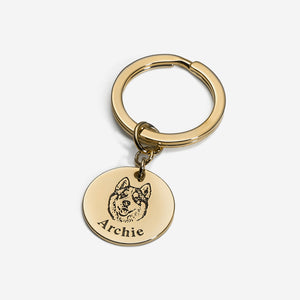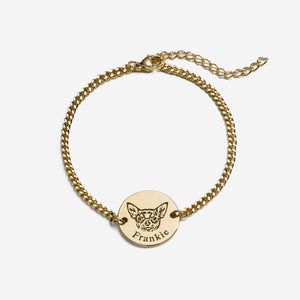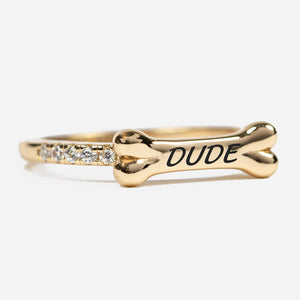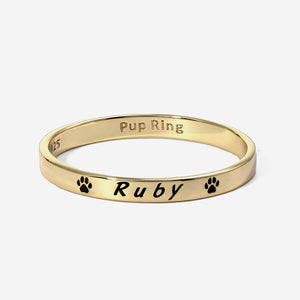Dogs grew and evolved alongside us humans for thousands of years. We learned to live together, support one another, and enrich each other’s lives- and they certainly didn’t lay around on the couch all day! Over time dogs were bred and trained to do work, sometimes very specialized based on their breed- Huskies pulling heavy sleds across the snow, Heelers herding sheep, Beagles tracking small game- but they all have one thing in common: they had a job to do, and they loved every minute of it!
Giving your pup a job is a sneaky way to promote good behavior, and an even greater way to give its mind and body a workout. Most dogs find having a job incredibly rewarding! Teaching your dog any of these jobs will require a bit of patience on your part and involve a process called “shaping” which you can learn all about here in “Shaping: The Art Of Teaching Your Dog Anything". These tricks can become useful in more ways than one, and are a great exercise in building your bond with your pup. Without further ado, here are a few jobs you can teach your pup to do!
1.Clean up toys
 Yes, you can teach your dog to pick up after itself! All you need are some toys, something your dog can put them in, and some treats. This is a good first exercise in shaping because the progression is very simple and comes naturally.
Yes, you can teach your dog to pick up after itself! All you need are some toys, something your dog can put them in, and some treats. This is a good first exercise in shaping because the progression is very simple and comes naturally.
Start getting your dog used to the idea that his toys have a designated home by putting your container of choice in a designated spot that your dog can easily see and reach. Whenever you choose to pick up after your dog, put the toys in their place. Your dog may even be delighted at the idea of walking up to their special toybox and choosing what to play with! This will also help your dog get even more used to the idea that toys belong in this spot.
When you’re ready to start training, get your treats ready and sit by the toybox with your dog. The more naturally curious your dog is, the easier it will be! Regular training with your dog is also a great way to build momentum and encourage them to try new things. Start by waiting for your dog to look directly at the box or even touch it. Basically you want your dog to understand that this object is interesting and important to the new trick you’re teaching and opens the door for them to start trying to interact with it as a jumping-off point.
Once your dog is expressing a lot of interest in the toybox, put one of its toys on the ground next to it. You want to guide your dog towards touching or picking up the toy and then touching the box. If your dog is confused, break the process down a little more- maybe instead of waiting for your dog to pick up the toy on its own accord, start rewarding for any direct attention they give to the toy. Wait to start associating any words or commands to the action until your dog is actually doing the trick- you want the command to have a clear connection to the action, and using it too early will water down its exact meaning in your dog’s mind.
By slowly connecting different steps, at some point your dog is likely to touch the toy to the box, or even drop it inside. That’s when you introduce a treat bomb! Give a whole bunch of treats and praise when our dog successfully puts away one toy, whether it is on purpose or a happy accident. Start associating a phrase by saying it when your dog is doing the trick, and you’re well on your way to a future where your dog is better at cleaning up after itself than your roommates! You can make this game even more exciting by teaching your dog the names of the different toys in its box and make a game out of finding the right toy.
Even better, I’m sure you could find other ways to get your dog to help tidy up! Once your dog knows how to pick up its own toys, try something else- maybe I’ll teach Cookie to put dirty laundry in a basket, since a certain someone has a tendency to leave lone socks laying around the house! (I’m looking at you, dearest husband!)
2.Carry groceries or other objects (using a backpack, bag, or basket)
When my mom was still a young, hyper, sometimes underfoot child, my grandma used to send her outside with a job to do- my grandma offered to pay her a dime for every four-leafed clover she found. My mom spent hours and hours diligently searching for her four-leaf clovers in hopes of collecting that sweet spare change. Why did grandma do this? No, she wasn’t obsessed with collecting lucky pants… she found a sneaky way to keep my mom outside and out of trouble!
 What does that have to do with your pup? Well, giving your pup a job is a good way to keep your dog so busy working that they can’t find a way to get into trouble, even if they tried! Teaching your dog to carry something, whether in a harness full of pockets, or a bag in their mouth, will have them so focused on working that they can’t misbehave. It’s hard to bark at a squirrel when you have a grocery bag in your mouth! And, as always, a tired dog is a well-behaved dog.
What does that have to do with your pup? Well, giving your pup a job is a good way to keep your dog so busy working that they can’t find a way to get into trouble, even if they tried! Teaching your dog to carry something, whether in a harness full of pockets, or a bag in their mouth, will have them so focused on working that they can’t misbehave. It’s hard to bark at a squirrel when you have a grocery bag in your mouth! And, as always, a tired dog is a well-behaved dog.
If you want to teach your dog to carry something in its mouth, try to pick out one specific bag or basket for them to use. This will make it less likely that they will try to drag your fancy leather purse around the house if given the opportunity. While it may be a little awkward at first for your dog to drag around a container, it will become a natural course of action with the right training!
Using a similar shaping technique to the previous trick, teach your dog to be interested in the container (bag or basket), then to take the handle in its mouth and carry or drag it around. Make sure that you make it clear that the goal is not to chew on the container by interrupting your dog if it lays down and starts chomping on it instead of moving around. Avoid associating the container with its own toys- such as by putting it away or out of reach when you’re not asking your dog to use it.
Once your dog is used to casually holding the handle of their container, encourage them to walk around with it by moving away and encouraging them to follow. Give lots of praise and treats when they bring their little carrying container around! Now you’re on the path to putting something inside and making your dog a little delivery monster! This is especially useful for getting your dog to carry groceries inside (as long as there’s nothing too tempting inside to eat!). If you have your dog carrying something in its mouth for you, you can also use this to your advantage in situations where your dog may be prone to barking or snatching up interesting objects. It’s hard to bark with a mouth full of stuff! Give your dog something interesting to carry when you’re expecting guests or you see the mailman walking up to your door. Maybe find something to bring with you on a walk, and when you spot something your dog may get a little crazy about, hand over their little carrying container and they’ll be so focused on their new task that they won’t notice whatever trouble is in the distance.
 You can also go the simpler route and have your dog carry a backpack, or even just a harness with pockets on it. I used this trick a lot with young Cookie! This is especially great for dogs that are bred for work and high energy, such as huskies that were bred to drag around sleds! It won’t take as much training as carrying a bag or basket, but it’s still a fantastic way to give your dog a simple yet satisfying job to do. You can have your dog carry around anything from its own treats or doggy bags on regular walks, to water and snacks for hikes, or even just load the pockets down with rocks and let them run around the house to wear themselves out. It might seem like a silly way to exercise your dog, but many pups absolutely love having a job to do for their owner! And come on, you have to admit it’s a pretty creative solution to an energetic pup stuck indoors.
You can also go the simpler route and have your dog carry a backpack, or even just a harness with pockets on it. I used this trick a lot with young Cookie! This is especially great for dogs that are bred for work and high energy, such as huskies that were bred to drag around sleds! It won’t take as much training as carrying a bag or basket, but it’s still a fantastic way to give your dog a simple yet satisfying job to do. You can have your dog carry around anything from its own treats or doggy bags on regular walks, to water and snacks for hikes, or even just load the pockets down with rocks and let them run around the house to wear themselves out. It might seem like a silly way to exercise your dog, but many pups absolutely love having a job to do for their owner! And come on, you have to admit it’s a pretty creative solution to an energetic pup stuck indoors.
3.Find things or people
If you’ve ever seen pictures of hardworking rescue dogs or police pups, you know they have a keen mind and determination when it comes to finding things (whether it’s a person buried under rubble, or less savory substances that are well-hidden). Your dog doesn’t have to be a professional to start finding things though! Any dog can learn to seek out objects, other animals, or even people! All it takes is a little bit of training, learning names, and our favorite training technique, shaping.
First you need to teach your dog names! I’ve done this before with Cookie- I taught him the names of his toys when learning to clean up, and I also trained him to find my cat Tux on command. Here’s how you teach a name- walk right next to and point to the thing or person you want your dog to associate with a name, and say it out loud (Tux). If you’re teaching the name of an object, you can hold it in your hand (Duck toy). Look for your dog to get interested in what you’re doing. I waited until my dog looked at Tux instead of me, and did a treat and praise, then after a few times moved on to him touching Tux with a nose or paw (my cat and dog are buddies so he didn’t mind). After several successful executions of the touch-the-object command, I started trying it while Cookie was further away from the goal. This continued until we started practicing with Tux in a different room or behind an object. Now if I ever want to know where my cat is without looking by myself, I can just get my dog to find him instead!
 There are tons of useful ways to apply this trick too- if you’re prone to losing your keys or misplacing your shoes, you can teach your dog the names of those objects, and surprise! You have your own little four-legged tracking device. You can also use this to teach your dog the names of people. Instead of shouting across the house for someone, just send your dog over to fetch them! Start combining this with other tricks, like carrying objects, and before you know it you’ll have your dog delivering a surprise flower to your partner who's busy working in a room across the house.
There are tons of useful ways to apply this trick too- if you’re prone to losing your keys or misplacing your shoes, you can teach your dog the names of those objects, and surprise! You have your own little four-legged tracking device. You can also use this to teach your dog the names of people. Instead of shouting across the house for someone, just send your dog over to fetch them! Start combining this with other tricks, like carrying objects, and before you know it you’ll have your dog delivering a surprise flower to your partner who's busy working in a room across the house.
What kind of job would you like your dog to do?
If you’d like something a little different or need new ideas, try looking up what tasks your dog’s breed was shaped to do. You may be surprised at the wide range of working dogs there are! This can also help you find a task your dog will pick up more quickly! Or, if it’s a little more than you feel comfortable teaching right away, you can always stick to a simple training regiment of easy tricks like sit and shake. As long as you’re spending time with your pup and encouraging them to think, you’re both doing great!
Anyway, thank you for reading this week’s blog, I hope you stay happy and healthy, and I look forward to writing for you again next week!







